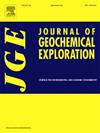断控型地热系统气体地球化学特征及热源机制——以武公山西部地区为例
IF 3.4
2区 地球科学
Q1 GEOCHEMISTRY & GEOPHYSICS
引用次数: 0
摘要
受活动断裂带控制的地热系统是可持续能源勘探的重要组成部分,但其流体成因和热源机制在复杂构造环境下仍不清楚。通过对西五公山地区多个水体中溶解气体的化学组成和同位素数据的研究,阐明了该区热液挥发物的来源、储层温度、岩石圈热结构和热源机理。结果表明,该区天然气组合以N2 (74.51 ~ 90.83 vol%)为主,其次为O2 (3.58 ~ 18.19 vol%)和CO2 (1.17 ~ 5.93 vol%)。氦同位素特征(0.08 ~ 0.16 Ra)表明主要的地壳放射性成因(97.79 ~ 99.21%),δ 13cco2值(- 11.9‰~ - 21.9‰VPDB)和δ13CCH4值(- 49.8‰~ - 74.8‰VPDB)表明CO2主要来自地壳有机源,CH4主要通过热生和微生物作用产生。IMG和CO2-CH4气体同位素地温计的应用表明,深层气源温度在100.2℃~ 197.3℃之间,略高于地热水储层温度范围120.3℃~ 137.1℃。综合分析3He/4He、钻孔测温及岩石热物性特征,研究区岩石圈热结构为“热壳-冷地幔”,壳幔热流比为1.36 ~ 1.56。最后,提出了西五公山地区断控地热系统的热源机制:(1)毯状热流传导和莫霍面减薄扩散的热富集;(2)地壳集中层放射性衰变热;(3)深断层对流热。该研究为断层控制地热系统的热源机制研究提供了新的视角,为类似成因地热资源的勘探利用提供了重要参考。本文章由计算机程序翻译,如有差异,请以英文原文为准。
Gas geochemical characteristics and heat source mechanisms of a fault-controlled geothermal system: A case study from the western Wugongshan area, South China
Geothermal systems controlled by active fault zones represent a critical component of sustainable energy exploration, yet their fluid genesis and heat source mechanisms remain poorly constrained in complex tectonic settings. This study investigates the chemical composition and isotopic data of dissolved gases from multiple water bodies in the western Wugongshan area to elucidate the sources of hydrothermal volatiles, reservoir temperature, lithospheric thermal structure, and heat source mechanisms. Our findings reveal a distinctive gas assemblage dominated by N2 (74.51–90.83 vol%), with subordinate O2 (3.58–18.19 vol%) and CO2 (1.17–5.93 vol%). Helium isotopic signatures (0.08–0.16 Ra) indicate a primary crustal radiogenic origin (97.79–99.21 %), while δ13CCO2values (−11.9 ‰ to −21.9 ‰ VPDB) and δ13CCH4 values (−49.8 ‰ to −74.8 ‰ VPDB) suggest that CO2 predominantly originates from crustal organic sources and CH4 is primarily generated through thermogenic and microbiological processes. The application of IMG and CO2-CH4 gas isotope geothermometers indicates that the temperature of the deep gas source varies between 100.2 °C and 197.3 °C, which is marginally above the temperature range of the geothermal water reservoir, recorded at 120.3 °C to 137.1 °C. Furthermore, integrated analysis of 3He/4He, borehole temperature measurements, and rock thermophysical properties indicate that the lithospheric thermal structure of the study area is classified as “hot crust-cold mantle,” with a crust-mantle heat flow ratio ranging from 1.36 to 1.56. Finally, the heat source mechanism of the fault-controlled geothermal system in the western Wugongshan area was presented: (1) thermal accumulation of blanket-shaped heat flow conduction and Moho surface thinning diffluence; (2) radioactive decay heat from crustal concentrated layers; and (3) convective heat from deep faults. This study provides a new perspective on the heat source mechanisms of fault-controlled geothermal systems and serves as an important reference for the exploration and utilization of geothermal resources with similar origins.
求助全文
通过发布文献求助,成功后即可免费获取论文全文。
去求助
来源期刊

Journal of Geochemical Exploration
地学-地球化学与地球物理
CiteScore
7.40
自引率
7.70%
发文量
148
审稿时长
8.1 months
期刊介绍:
Journal of Geochemical Exploration is mostly dedicated to publication of original studies in exploration and environmental geochemistry and related topics.
Contributions considered of prevalent interest for the journal include researches based on the application of innovative methods to:
define the genesis and the evolution of mineral deposits including transfer of elements in large-scale mineralized areas.
analyze complex systems at the boundaries between bio-geochemistry, metal transport and mineral accumulation.
evaluate effects of historical mining activities on the surface environment.
trace pollutant sources and define their fate and transport models in the near-surface and surface environments involving solid, fluid and aerial matrices.
assess and quantify natural and technogenic radioactivity in the environment.
determine geochemical anomalies and set baseline reference values using compositional data analysis, multivariate statistics and geo-spatial analysis.
assess the impacts of anthropogenic contamination on ecosystems and human health at local and regional scale to prioritize and classify risks through deterministic and stochastic approaches.
Papers dedicated to the presentation of newly developed methods in analytical geochemistry to be applied in the field or in laboratory are also within the topics of interest for the journal.
 求助内容:
求助内容: 应助结果提醒方式:
应助结果提醒方式:


